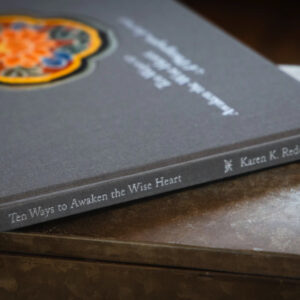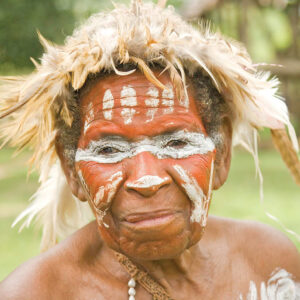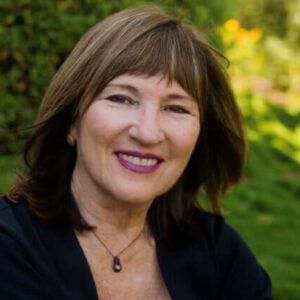This month we are sitting down with InsightLA teacher Karen Redding LCSW, Ph.D., the author and photographer behind a captivating book of meditative photographs called Ten Ways to Awaken the Wise Heart: A Photographic Journey. Driven by a desire to speak to and from the heart in simple yet profound ways, Karen sought to create a genuinely transformative experience through the power of imagery while documenting her travels around the globe. Each photograph, accompanied by a poignant text, becomes an anchor for introspection, allowing readers to connect with their own hearts and embark on a journey of self-discovery. Join us in this installation of ‘Community Insights’ as we unravel the inspirations and insights behind this captivating collection of photographic meditations.
 “It is the work of a true artist to give us fresh eyes to see the world anew, to melt open our hearts with visionary tenderness, and to remind us of our spiritual power. With a truthful eye and a caring heart, Karen brings us along on her journey of decades of world exploration.”
“It is the work of a true artist to give us fresh eyes to see the world anew, to melt open our hearts with visionary tenderness, and to remind us of our spiritual power. With a truthful eye and a caring heart, Karen brings us along on her journey of decades of world exploration.”
– Trudy Goodman and Jack Kornfield
Q: We started by reading Trudy Goodman and Jack Kornfield’s perspective and glowing recommendation of your book in the foreword, but what were your intentions in creating Ten Ways to Awaken the Wise Heart: A Photographic Journey?
Foremost of my intentions in writing this book was to communicate in language that escapes jargon, that speaks to profound ideas in simple ways. I constructed the book using photography and image so it implies a backstory. The reader sees something of where and when this photograph was taken, and this sets the image in a time zone. But I use the narrative that comes with each of the photographs to go into the heart zone, a more timeless space.
The photograph becomes an anchor for a meditative reverie such that the participant, the reader, is able to use the image of the photograph as a way of connecting to their own heart. As a way of connecting to a deeper inquiry. So then it’s not just about what happened out there at that time in this photograph, but it begs further questioning. How is this speaking to me? How is the narrative and inquiry also a tool for taking me inside myself, and not just as an objective observer of somebody out there?
The book is formatted in a similar way to our classes or courses at InsightLA – if you want to take a dip in the water you can just look at the photos and get an idea of the place, space, and context. Or go to the back and see the glossary and find out where the photos were taken. But if you want to use it as a guided meditation, you can read the reflection, and then maybe go into the inquiry in a similar way to how we do in the Mindful Self-Compassion courses. The question becomes, what do I know about this heart quality of generosity? What do I really know about this heart quality of generosity? What do I really, really know about this heart quality of generosity? We can go deeper and deeper.
Q: How did you create the meditations that go with the texts?
To write the book I would sit and meditate and from that meditation I would use these prompt questions with myself, so that I could try to write from that more personal place of experiential, rather than from some third person, objective, cerebral place. So my hope was that some portion of the readers would actually use it as a sort of daily meditation, or meditate together in a group format using the prompts as a starting point.
 As part of my psychotherapy practice, I’m leading a pilot program in Laguna Beach with women, and we’re using the book’s images and texts as a jumping off point for meditative experience. Each month we’re focusing on one of the 10 qualities of the Paramis. In Buddhist thought the Paramis are sometimes called the ‘perfections’ – qualities that buddhists practitioners are encouraged to cultivate to live a good life. I like to call them ‘treasures of the heart’. So there’s a teaching component that comes with it. I’ve been constructing guided meditations across each of the 10 qualities of the heart, so that there’s practice, and then there’s an inquiry, and then I open it up to the group with the inquiry. So that there is that opportunity for interactive exchange where we can have reveries together and see what comes up, what people think and how that adds to what I was thinking when I wrote the book.
As part of my psychotherapy practice, I’m leading a pilot program in Laguna Beach with women, and we’re using the book’s images and texts as a jumping off point for meditative experience. Each month we’re focusing on one of the 10 qualities of the Paramis. In Buddhist thought the Paramis are sometimes called the ‘perfections’ – qualities that buddhists practitioners are encouraged to cultivate to live a good life. I like to call them ‘treasures of the heart’. So there’s a teaching component that comes with it. I’ve been constructing guided meditations across each of the 10 qualities of the heart, so that there’s practice, and then there’s an inquiry, and then I open it up to the group with the inquiry. So that there is that opportunity for interactive exchange where we can have reveries together and see what comes up, what people think and how that adds to what I was thinking when I wrote the book.
So I’m finding in this launch with this book, that it can be a coffee table book, something that’s just pretty that can be thumbed through. And it can be sort of a curriculum, a foundation for learning these heart practices of the Paramis more experientially. Or it can be used solo – some people use it as a journal and might reflect on a page and that page will sort of stay with them through the day. This way the reader is able to use the inquiry as a way of deepening access or felt experience to whatever the image and its heart quality is.
Q: How does the book help with the mental afflictions or emotional upsets that we all go through everyday?
Well as mindfulness practitioners we’re not only interested in what supports the arising of the quality, but also what blocks it. I’m very interested in resistances – I don’t find resistances to be a problem. I find resistances to really be useful to get to the root of and understand what that resistance is about. So there’s a little exploration with that, too. Sometimes people will say to me “I’m a mother, I’m a wife, I’m a grandma, I feel like I know a lot about generosity, and it wears me out.” And that’s why I was very careful in recognizing this quality of generosity to really highlight that charity begins at home. But if we can’t begin with ourselves, we’re not going to have the staying power to be all that generous in the world. And so that block to generosity can help us see what needs to be balanced.
Q: Can you talk us through your use of the ‘paramis’ or heart treasures, as you utilize them in the book?
What are the paramis? Although these 10 qualities to be cultivated are often referred to as perfections in the Buddhist texts I try not to talk about it so much as perfections it gets people into their head. I prefer to describe them as the 10 treasures of the heart and they give us more rooms or heart spaces to play with, to practice in. So we’re not just in the room of metta, or the room of Mindful Self-Compassion, but we’re going into rooms of courage, rooms of patience, rooms of releasing and letting go! It gives us more perspectives on the heart to help us recognize, explore, access, and inquire.
Q: Can you speak to the resonances (or not) between the practice of meditation and the practice of photography?
My practice of meditation does involve learning how to quiet my mind, how to steady my heart, how to anchor so that I can keep coming back to a meditative object, given the natural tendency of the mind to wander. And the practice of photography also begins with technique. I think it is important to know your camera. I mean, I very recently just got a new Canon R5. It’s really complicated. I’ve engaged a mentor, a teacher to help me figure it out – just as you would learning to meditate. But once we have that technique then there’s an anchor. It’s about learning to see not just with our eye, but learning to see with bodhicitta our mind or heart. So that we’re really able to enter more of a felt experience, not just a cognitive experience. How can I use that to make a good photograph? As a photographer, I try to feel my way into a photograph. As a psychotherapist, I try to feel my way into listening to people’s material about what they’re sharing with me. And so technique is important, it’s a useful tool.
 But it doesn’t stop there. Because technique takes us into places where we can become more, more spacious, more creative, and maybe discover ways of seeing that something we thought that was awful, or something that we thought was, you know, difficult to look at, maybe we can hold unexpected ways of finding beauty in the challenge, or find wisdom there, or maybe just some interest there. Feeling into experience is part of my practice – in making a photograph, being a psychotherapist, a Dharma teacher, as well as being a meditation practitioner. So it all comes together.
But it doesn’t stop there. Because technique takes us into places where we can become more, more spacious, more creative, and maybe discover ways of seeing that something we thought that was awful, or something that we thought was, you know, difficult to look at, maybe we can hold unexpected ways of finding beauty in the challenge, or find wisdom there, or maybe just some interest there. Feeling into experience is part of my practice – in making a photograph, being a psychotherapist, a Dharma teacher, as well as being a meditation practitioner. So it all comes together.
Q: Speaking of obstacles, what were some of the resistances that came up in you while creating this book?
I questioned myself in so many ways. Am I saying anything different? Am I saying anything more original? Am I saying anything deeper? I got into the judging mind, the comparing mind, the fixing mind. I had to be careful not to do a lot of other reading of other authors who have written on the Paramis because I wanted it to be my flavor, my take. At times I was steeped in those universal resistances: Is it good enough? How am I comparing it? Am I judging it? Do I need to fix it in some different way? It was quite a journey.
Q: Tell me a little about the first time that the transformative power of photography dawned upon you?
That’s a really good question. A lot of my photography is travel photography. And the travel has been done with my husband and son. Not so much with group tours, mostly with the three of us. And we’ve liked adventure travel. It started in Namibia in Africa. We had the opportunity to travel with a man who was not only a guide, but a photographer. And he really gave me a way of seeing Namibia. The landscape is almost blonde, there’s this wheat coloring on the fields and in the light too. And we went in to see some indigenous people, the Himba people. And I remember, in going into that village, and at that time, I did have a Canon camera but this was an older one. I remember taking photographs of the people, especially the women. They invited me to put on some of the mud clay that they had on their faces. And so I began to do that. And our guides started also taking pictures of me taking pictures of them. But as I was taking pictures of them, sort of being with them in that sort of experiential way the women really wanted me to take off my clothes and although I didn’t, I did get to play with the interaction in a beautiful was that reminded me of what Dorothea Lange said of photography – the function of the camera is really just an instrument to teach people how to see without a camera.
 So that’s what happened on this trip. I was thinking about pictures, photographs. But then I sort of forgot about the camera. And I just started sort of merging more with my subject in playful ways. And felt my way into my subject. When I came home from that trip it was 2007, so I really haven’t been at this very long. I live in Laguna Beach right above the Festival of the Arts and I went that summer and I looked particularly at the photography exhibit there to find a teacher, just like we do with Dharma, just like we do with a therapist. To find a teacher, somebody whose work speaks to me. And I found my teacher, Dennis Jones, and I have worked with him since 2007. I pretty quickly had my first show in 2008, here in Laguna and I called my beginning body of work ‘Travels Through Humanity’. Because I was very interested in our differences, what makes us unique, but again, given my dharma background, and my mental health background, I’m also interested in what makes us the same.
So that’s what happened on this trip. I was thinking about pictures, photographs. But then I sort of forgot about the camera. And I just started sort of merging more with my subject in playful ways. And felt my way into my subject. When I came home from that trip it was 2007, so I really haven’t been at this very long. I live in Laguna Beach right above the Festival of the Arts and I went that summer and I looked particularly at the photography exhibit there to find a teacher, just like we do with Dharma, just like we do with a therapist. To find a teacher, somebody whose work speaks to me. And I found my teacher, Dennis Jones, and I have worked with him since 2007. I pretty quickly had my first show in 2008, here in Laguna and I called my beginning body of work ‘Travels Through Humanity’. Because I was very interested in our differences, what makes us unique, but again, given my dharma background, and my mental health background, I’m also interested in what makes us the same.
When I think about it in terms of metta, we all want to be safe, we all want to be happy. We all want to be healthy. We all want to be free of suffering. So I’ve been playing with both sides of that – what’s different about us in terms of ‘how do we relate?’ ‘How do we practice?’ Being in our culture, being in our family, but also what makes us the same? My work as a photographer tries to get at these questions, to feel into these questions in a way that is both meditative, inspiring and can be approached as beautiful images or as deeper reflections. That’s really where Ten Ways to Awaken the Wise Heart: A Photographic Journey came from.
________________________________
If you’d like to buy Ten Ways to Awaken the Wise Heart: A Photographic Journey go to Karen’s website. 50% of the proceeds will benefit the InsightLA ‘Insight in Action’ program to bring mindfulness to underserved communities.
 |
Karen Redding LCSW, Ph.D. facilitates a community sitting-group in Laguna Beach as an ‘outpost’ of InsightLA in Laguna Beach, and presently serves on the InsightLA Teacher’s Council. She has several decades of experience as a dedicated practitioner at InsightLA with residential retreat experience under the primary guidance of Trudy Goodman and Jack Kornfield. Karen completed the Dedicated Practitioner’s Program at Spirit Rock as well as the Facilitator’s Training Program at InsightLA and has been involved in the Teacher’s Development Group at ILA for more than a decade. |
